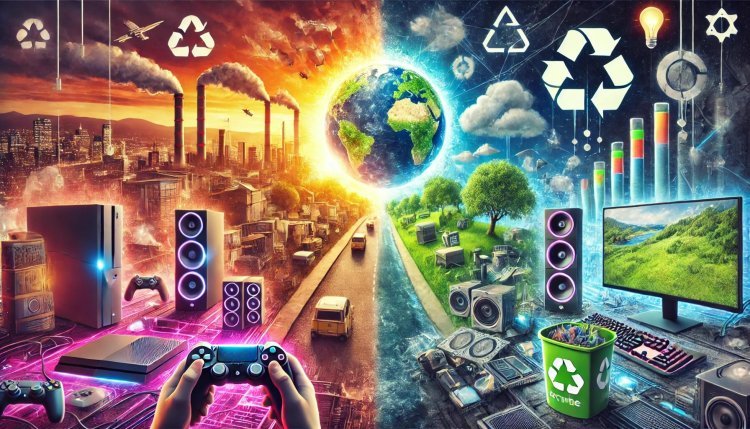Sustainability Challenges in the Gaming Industry Today
Explore sustainability challenges in the gaming industry, including energy consumption, e-waste, and carbon footprints. Learn how the sector is adapting to environmental concerns.

The gaming industry, a global phenomenon generating billions in revenue, is increasingly under scrutiny for its environmental impact. From energy consumption to e-waste, the industry faces significant sustainability challenges that demand attention. As gaming evolves, the push for environmentally friendly practices becomes more critical.
Energy Consumption: Powering an Industry
The gaming industry’s energy consumption is staggering. High-performance gaming consoles, PCs, and servers require substantial power, often sourced from non-renewable energy. Cloud gaming, a growing trend, exacerbates this issue. Platforms like Google Stadia and Xbox Cloud Gaming rely on massive data centers, which consume enormous amounts of electricity to operate and cool.
Efforts to address this include using renewable energy sources. Companies like Microsoft have pledged to run their operations on 100% renewable energy by 2030, setting an example for the industry. However, widespread adoption remains a challenge, particularly for smaller developers and companies with limited resources.
E-Waste and Recycling
E-waste is a pressing issue in the gaming sector. With frequent hardware upgrades and new console releases, discarded electronics pile up in landfills. Gaming peripherals such as controllers, headsets, and graphics cards contribute significantly to this problem.
Recycling initiatives are crucial but underutilized. Some companies have introduced take-back programs, encouraging users to recycle old consoles and accessories. For instance, Sony’s “Take Back” initiative promotes responsible recycling of PlayStation products. Yet, a lack of consumer awareness and accessible recycling facilities hampers these efforts.
The Carbon Footprint of Game Development
Developing a video game involves a complex process that leaves a significant carbon footprint. Studios use energy-intensive equipment, and team travel for motion capture, events, and promotions adds to emissions. The shift to remote work during the COVID-19 pandemic demonstrated how reducing office-related energy use and travel can benefit the environment.
Innovations like virtual production techniques, seen in games like The Last of Us Part II, help reduce the environmental impact. By adopting such sustainable practices, the industry can balance creativity and responsibility.
Packaging and Physical Media
Physical game copies and their packaging contribute to deforestation and plastic waste. While digital distribution has gained popularity, it’s not a panacea; digital downloads and streaming services still rely on energy-intensive data servers.
Some companies are exploring eco-friendly packaging options. For example, Ubisoft has replaced plastic game cases with cardboard alternatives for certain releases. However, consumer demand for collectibles and limited editions, often laden with plastic components, complicates progress in this area.
Sustainable Game Design
Sustainability can also be integrated into game design. Titles like Minecraft and Civilization VI incorporate themes of environmental stewardship, educating players on sustainability while entertaining them. This approach leverages the power of gaming to influence behavior positively.
Developers can further explore in-game systems that encourage players to adopt eco-friendly practices. For example, a game could reward players for building renewable energy sources or managing waste effectively, subtly reinforcing real-world values.
Industry Collaboration and Advocacy
Collaboration is essential to address sustainability challenges effectively. Initiatives like the Playing for the Planet Alliance, supported by the United Nations, bring together gaming companies to commit to environmental actions. Members, including Sony and Microsoft, have pledged to reduce carbon emissions, incorporate green messaging in games, and improve energy efficiency.
Advocacy for stricter regulations and incentives for sustainable practices can also drive change. Governments can play a role by offering tax breaks for companies using renewable energy or imposing penalties for excessive e-waste production.
The Role of Gamers
Gamers themselves can contribute to a more sustainable industry. By supporting companies with green initiatives, choosing energy-efficient devices, and responsibly disposing of old hardware, players can make a difference. Community-driven movements, such as campaigns promoting eco-friendly gaming habits, further amplify these efforts.
Additionally, gamers can advocate for change by voicing their preferences for sustainable practices. Social media and forums provide platforms for discussions that can influence industry trends and priorities.
The Road Ahead
The gaming industry faces an uphill battle in achieving sustainability, but progress is possible with innovation, collaboration, and awareness. By prioritizing renewable energy, reducing e-waste, and integrating sustainability into game design, the industry can align its growth with environmental responsibility.
The journey toward a sustainable gaming future is challenging yet achievable. As technology advances, so too must the commitment to preserving the planet for future generations of gamers and developers alike.If you have experiences or insights on gaming in your community, we invite you to share your story with us at write for us gaming!
What's Your Reaction?















